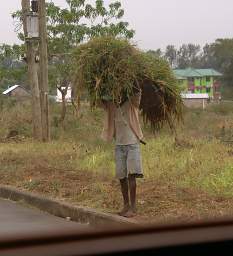
We left Kiota Guest House in good time; Our goal for the day was Tarangire National Park, which lies southwest of Arusha. We stopped in Arusha to change some money, and to buy Dona a hat to replace her lost one. Somewhere I had read that traveler's cheques were an o.k. thing to use in Tanzania, so we had some. That may be a good idea in terms of safety / protecting your funds, but it is a terrible idea in terms of the exchange rate. None of the banks would change money, so we had to use one of the small money exchange businesses. They charged us a 10% premium to change traveler's cheques. There was quite a variation between the individual businesses in terms of the rate, but we didn't want to spend a lot of time to shopping around. Anyway, that was quite a bit different from the last time I used them, in Borneo, where I got a better rate using traveler's cheques than I did for cash because they were worried about counterfit dollar bills.
We traveled through a part of the Maasai Steppe, a dry landscape despite recent rains. Along the road we saw people walking, always walking ... or riding a bicycle. Many were on their way to fetch water or returning home with water on their heads. Others were carrying large bundles of grass. The Masai measure wealth in cattle, and some still maintain a small herd even when they don't have any grazing land to support them. The result is they have to go out every day and find feed, which they cut with a sickle or machete and haul back to the animals.
 |
| Grass For Cows |
The land we were traveling through was divided, with some of it used for farming and some reserved as communal grazing land. The grazing land was severely overgrazed, a classic case of the tragedy of the commons, a situation which is only going to get worse unless people change their attitudes or their grazing practices.
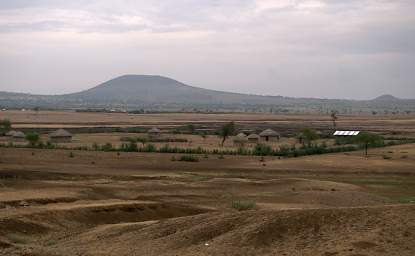 |
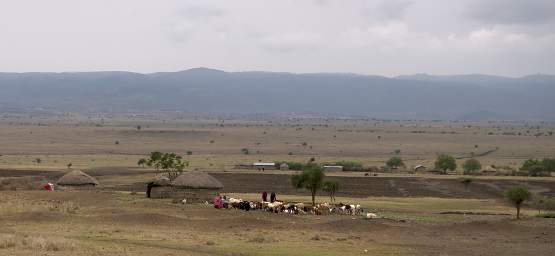 |
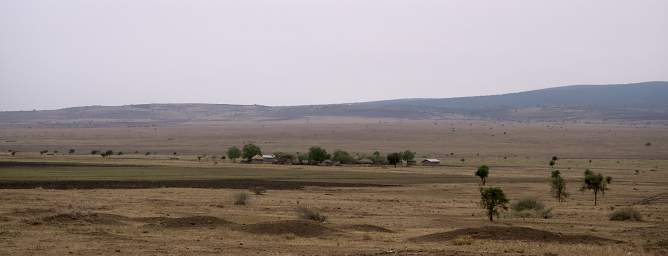 |
| Maasai Steppe |
Periodically we would pass a large pit which contained water. These were man-made, machine-dug waterholes. As we drove along, it was obvious where it had rained recently and where it had not. Douglas said that the grass responded very rapidly to rain, greening up in as little as one day. With a short growing season, the grass needs to get going in a hurry.
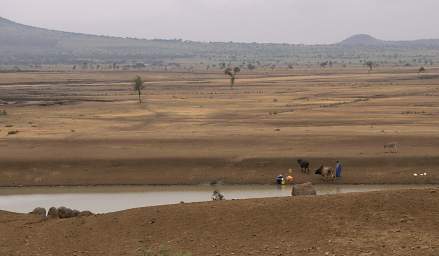 |
| Waterhole
The woman is filling jugs for use at home |
Periodically we would pass a few Sisal plants with their long flower stalks sticking up. Sisal is a member of the Agave family, and is native to Mexico, not Tanzania or anywhere else in Africa. The leaves of the plant are used to make fiber rope and twine. At one point sisal was a huge export product for Tanzania, but modern synthetics have supplanted the use of sisal in much of the cordage industry. While sisal is still commercially grown, it is not as large an industry as it used to be. They are still cool plants though! And you can easily make sisal twine for yourself from them.
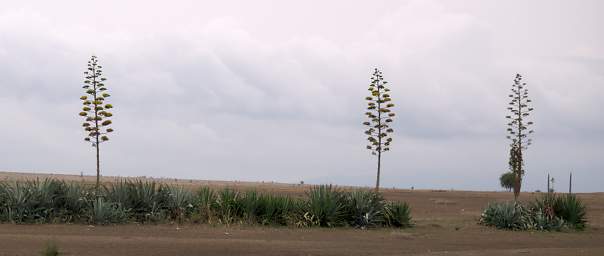 |
| Sisal |
At one point I became aware that every so often we would pass a tree with boxes handing in it. They looked like caskets, but that didn't seem likely. Douglas informed us they were bee hives. I think they were suspended in trees to prevent some animals from getting into them, but it probably also kept them somewhat cooler than if they were out in the open. The bee-hive trees reminded me of our boot tree and the one we saw on the Pieman River in Tasmania, but I like the bee-hives better.
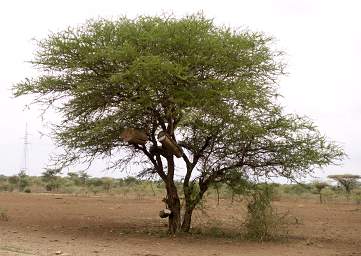 |
| Bee Hives |
We saw Maasai people walking everywhere, herding small bunches of cows and goats. We were miles from any town, and still people walking. Always in colorful clothing, predominantly red. Douglas said the red is not really preference, but is a result of what was predominantly available once upon a time. So now fabric dealers carry lots of red, and it is often less expensive as a result, so the trend perpetuates itself. One of the biggest problems for nomadic people like the Maasai is encroachment on their traditional grazing lands by farms. Governments have not learned how to properly protect communal grazing lands, and tend to view nomadic people as "useless," since they generally are mostly self-sufficient. They don't produce a lot of goods to sell, and they don't consume much. So they neither add to the gross domestic production, nor help a capitalistic society's desire/"need" for consumption. In short, they live the way most of us should in terms of consuming less and making low demands on the world's resources, but that puts them at odds with governments focused on western notions of capitalism. Once upon a time the Maasai could have protected their grazing lands from encroaching farms via tribal warfare, but now the government prefers farms because it views them as more productive. And so farming people slowly pinch in on traditional grazing lands, a new farm here, a new farm there, until the best land is no longer available for grazing. It was disheartening to see these proud people squeezed by their farmer neighbors and getting little support from their government.
Towards afternoon we arrived at Tarangire National Park, and things started looking up as soon as we entered the park gates. There was more ground cover, more trees, and we were immediately greeted by birds and animals.
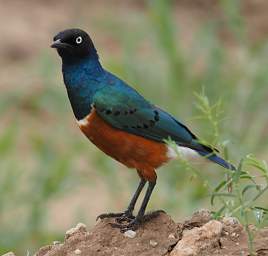 |
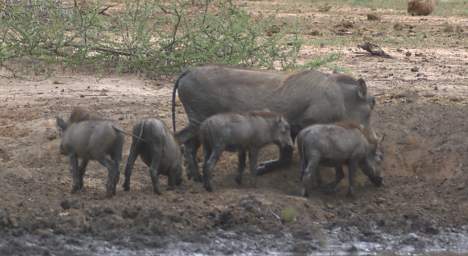 |
| Superb Starling
Photo by Dona |
Wart Hogs
Photo by Dona |
We arrived at our home for the next few days, Tarangire Safari Lodge. It has way more stars by its name than we are used to, and was a bit uncomfortable for me in that regard. I'm not very good at being waited on hand and foot, and prefer helping out with the camp chores and looking out for my own safety. It is a class act, and occupies a wonderful location overlooking the Tarangire River at the north end of the park.
When we arrived, there were elephants wandering around the camp, as well as zebras, impalas and more that I can't remember. We were pleased that our luxury tent was clear at then end, number 22, even if we were only a little more off in the wild. All of our "tents" in established camps had built in bathrooms in the end section, with showers to boot. The showers generally were fed from a 5 gallon pickle pucket raised up high and filled with solar- or fire- heated water. After dark, we were escorted back to our tent from the dining hall, as they are concerned people will not pay attention and end up in the stomachs of lions or leopards or trampled by elephants. Or something like that. I guess if you are not used to wild animals and paying attention it's appreciated, but I would rather deal on a "tourist beware" approach.
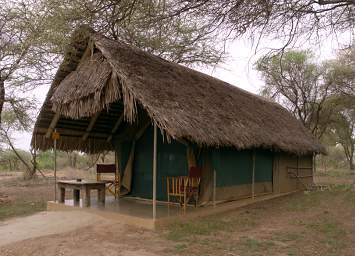 |
| Our "Tent" at Tarangire Safari Lodge |
Our first slow drive around the northern part of Tarangire National Park turned up a wonderful variety of wildlife.
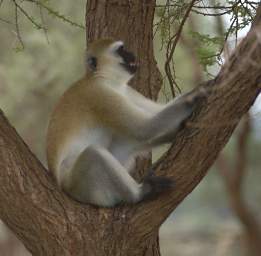 |
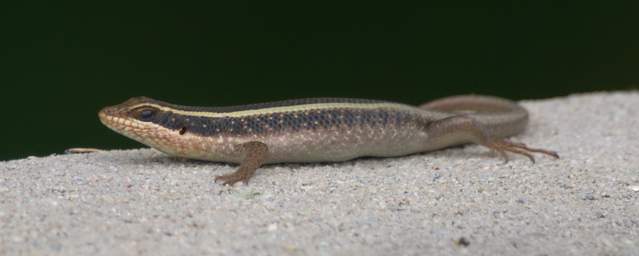 |
| Vervet Monkey | Striped Skink |
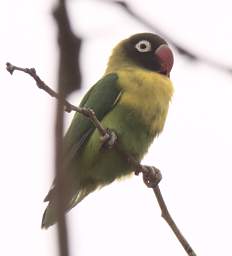 |
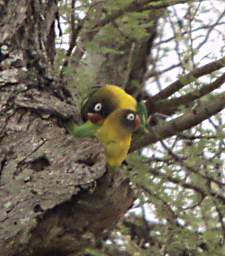 |
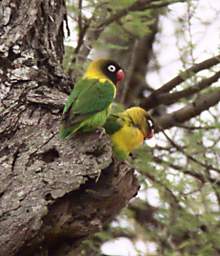 |
| Yellow Collared Love Bird | ||
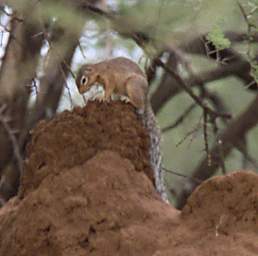 |
| Unstriped Ground Squirrel |
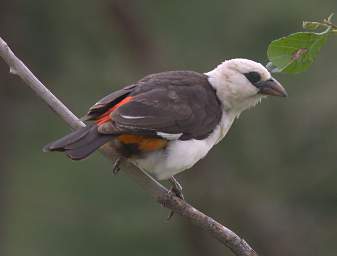 |
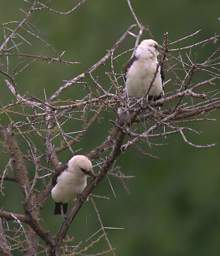 |
| White Headed Buffalo Weaver | |
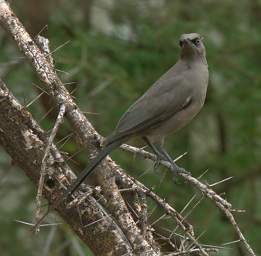 |
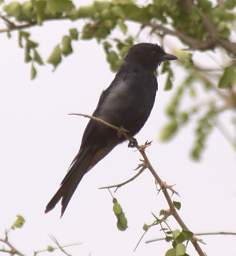 |
| Slate Coloured Boubou | Fork Tailed Drongo |
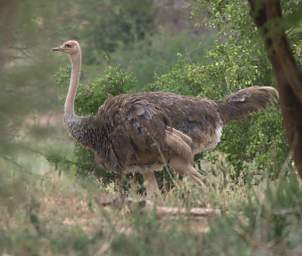 |
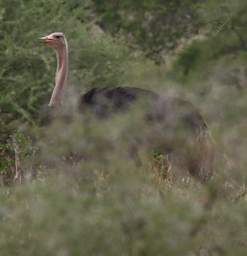 |
| Common Ostrich | |
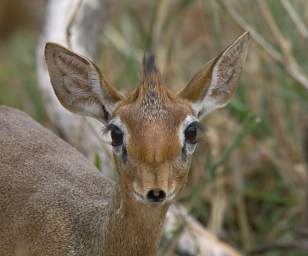 |
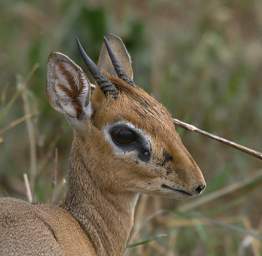 |
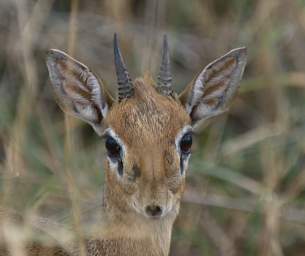 |
| Kirk's Dik Dik | ||
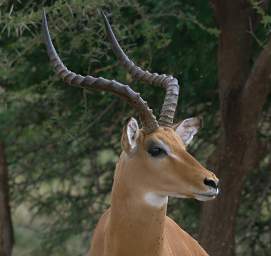 |
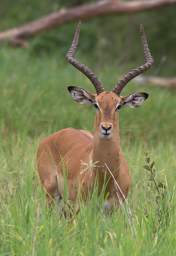 |
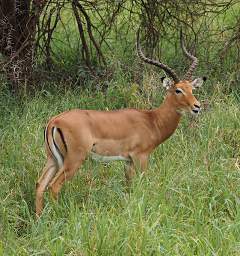 |
| Photo by Dona | ||
| Impala | ||
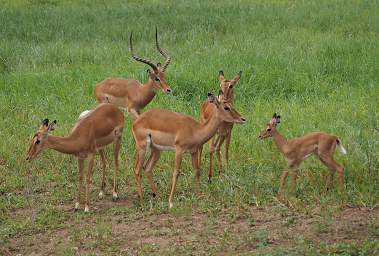 |
| Impala with his Harem
Photo by Dona |
If you say "termites" to anyone in the United States, they likely think of houses falling apart. If you say "termites" to someone in east Africa, they likely think of big dirt castles. In Africa Termites build huge mounds; they are efficiently cooled by convection using the heat differential between one side of the mound and the other, and they are oriented north-south so as to maximize the effect. We humans are now starting to learn from the termites to build passively cooled buildings.
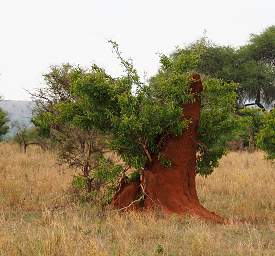 |
| Termite Mound
Photo by Dona |
Along with the termite mounds were wonderful big Baobab trees. They appear to be primo tree house candidates, something I would have given a lot for as a kid. Heck, I'd still like to have some nearby!
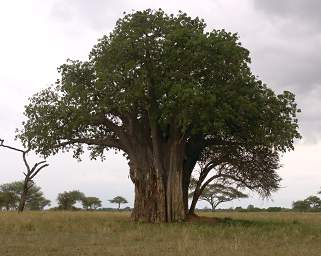 |
| Baobab |
Our search for birds did not disappoint, as we found what turned out to become one of Dona and my favorites -- the rollers. Stunning, particularly when the sun hits them just right on the wing.
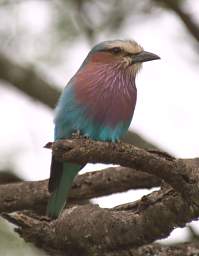 |
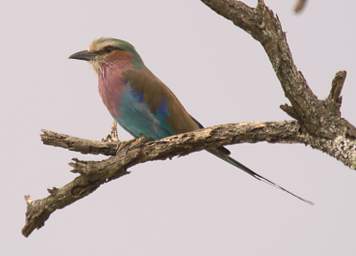 |
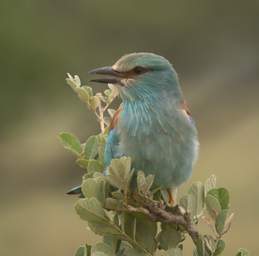 |
| Lilac Breasted Roller | Lilac Breasted Roller | European Roller |
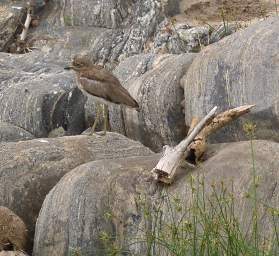 |
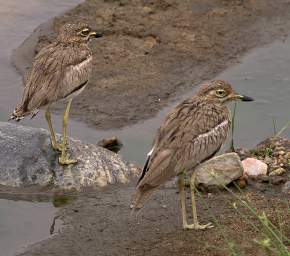 |
| Water Thick Knee | |
Tarangire National Park is known for its elephants, and it did not disappoint us. It was a real treat to see herds of elephants roaming freely, doing what elephants are supposed to do.
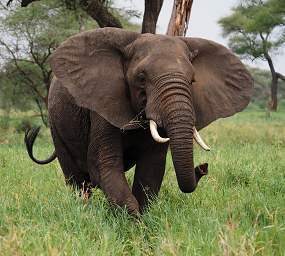 |
| Photo by Dona |
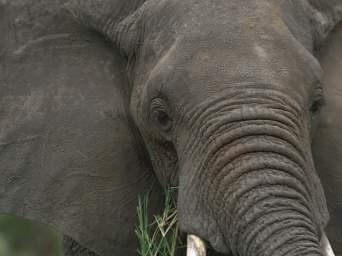 |
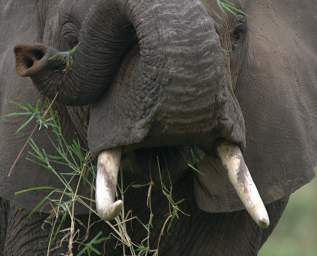 |
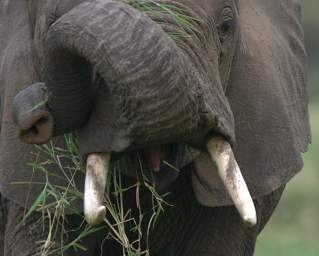 |
| Hmmm, we're getting a bit close... | Chowing down | Who would have thought
an Elephant Tongue was a Little Pointy Thing? |
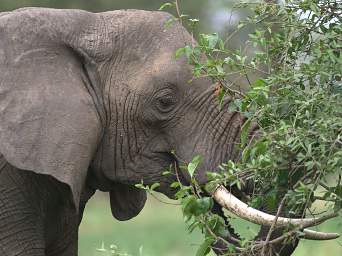 |
So, here's how a big beast that can't reach the grass with its mouth gobbles up vast quantities of the stuff. Makes you think a long nose might be pretty useful, huh?
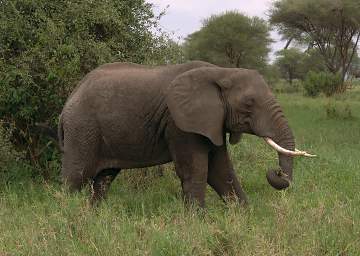 |
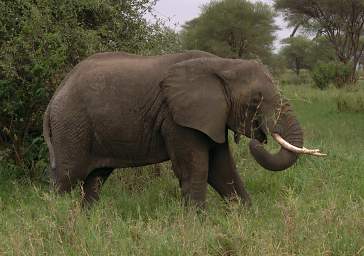 |
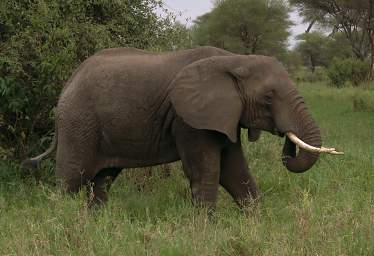 |
The young bulls below were hanging pretty close together. I got the impression they thought they were pretty big stuff, as long as they had each other for support, and as long as big bad mamas were far enough away to not threaten, but close enough to offer some protection that wasn't embarrassing. Sort of like youg bulls the world over.
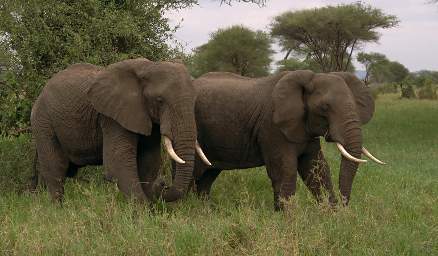 |
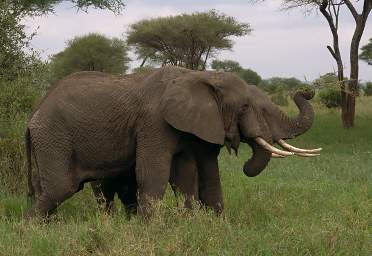 |
Birds, birds, birds! Our search for birds was constant, and constantly rewarded.
 |
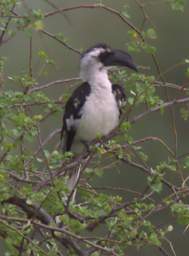 |
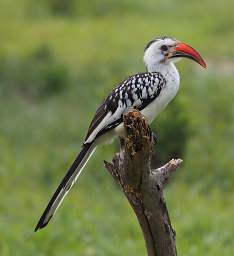 |
| Von Der Deckens
Hornbill Photo by Dona |
Von Der Deckens Hornbill
(female) |
Red Billed Hornbill
Photo by Dona |
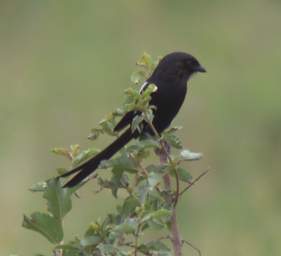 |
| Xxx |
Some of these birds, like the Saddle Billed Stork below, were just too bizarre looking to be seriously considered for actual bird status. It looks like someone slipped a brightly colored square cardboard cutout over its beak.
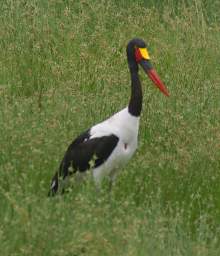 |
 |
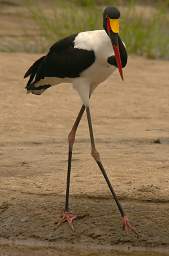 |
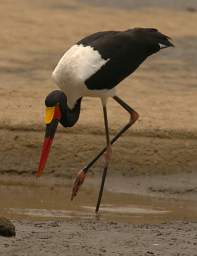 |
| Saddle Billed Stork | |||
We were delighted to find a small monitor lizard basking on a rock in the river when we crossed. It was pretty lethargic, and seemed like it might be a bit too exposed for achieving a long life.
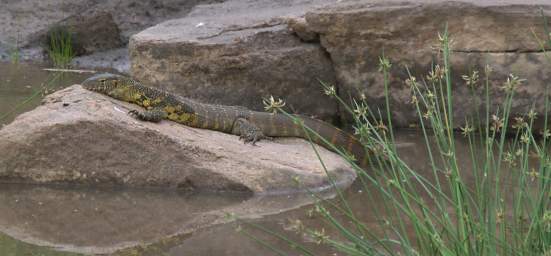 |
| Nile Monitor Lizard |
Baby birds are so vulnerable it makes me cringe every time I see them walking around in plain sight, as was the case with the Egyption Goose goslings below. How any of them survive is beyond me. They must rely at least partly on overwhelming demand, the same way the Wildebeests do.
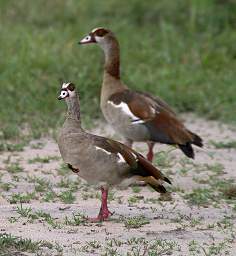 |
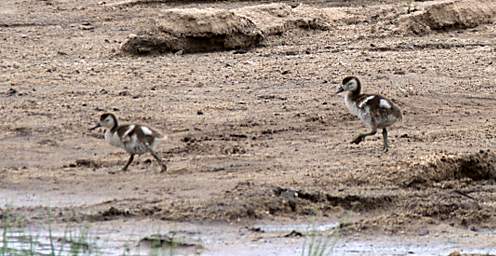 |
| Egyptian Geese | Egyptian Goose Goslings |
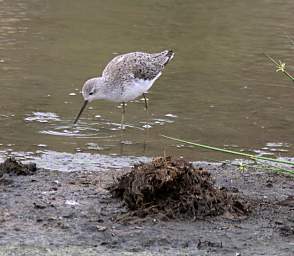 |
| Marsh Sandpiper |
I was fascinated watching a small herd of elephants with new babies along. The little guys are cute, but boy are they well protected. The kids just run around wherever they want, oblivious to any dangers. But there is always a mom, a big sister, an aunt, close at hand, and often directly overhead. Sometimes it looks like they would be trampled, but it's clear the bigger relatives are well aware of where their feet are being placed and where the little ones are. If I were a baby elephant, I would feel very secure. What a nice warm fuzzy way to get a start in life!
 |
| An Elephant Herd with Infants |
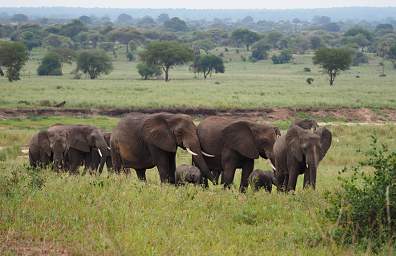 |
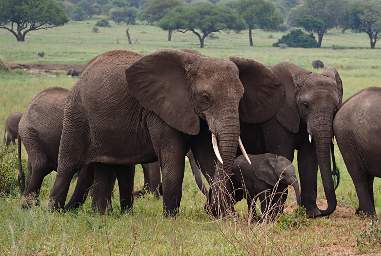 |
| Photo by Dona | Photo by Dona |
| Well-supervised Elephant Babies | |
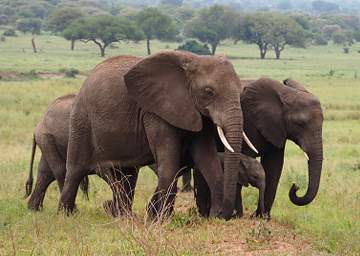 |
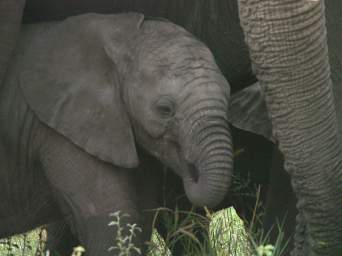 |
| Photo by Dona |
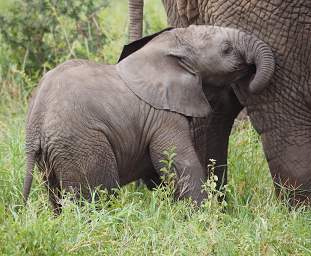 |
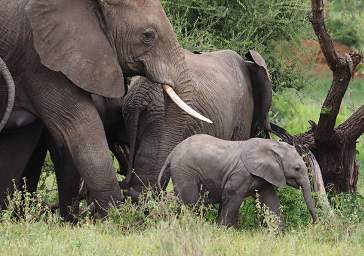 |
| This one looks a little worried,
like it's trying to get back under the protective canopy. Photo by Dona |
Photo by Dona |
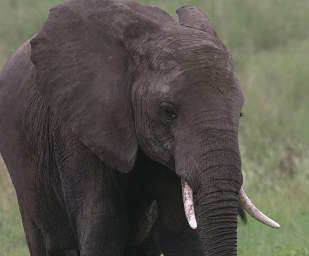 |
| Elephant Youngster |
 |
| How do they decide where they're headed? |
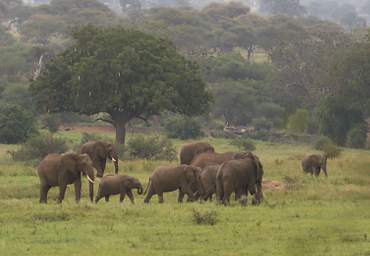 |
At one point we were close to a youngster who hadn't been paying attention while the rest of the herd wandered on their way. Once s/he discovered s/he was alone, s/he pretty much panicked. S/He wasn't raging mad, but it made one think it wouldn't be a good idea to be in the way of a distresed elephant.
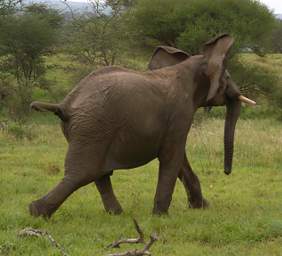 |
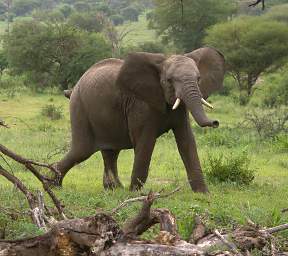 |
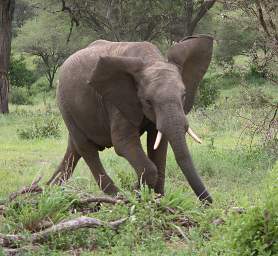 |
| Upset Elephant | ||
We, and everyone else in the park it seemed, found a couple of lionesses with young cubs. They were pretty boring to watch after a while, but I guess that's what lions do when they aren't hungry -- not much.
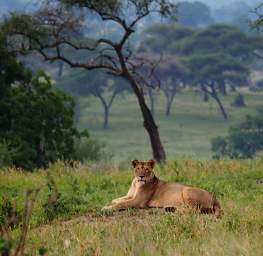 |
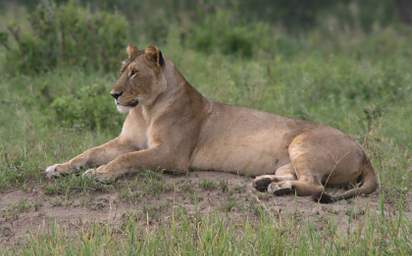 |
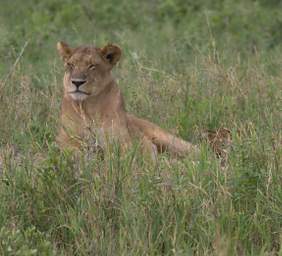 |
| Lioness
Photo by Dona |
Lioness | Lioness with Cub |
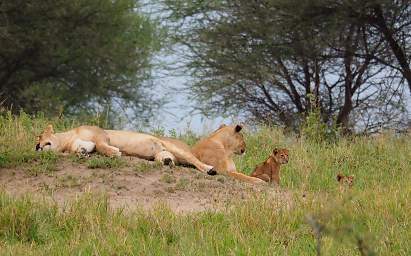 |
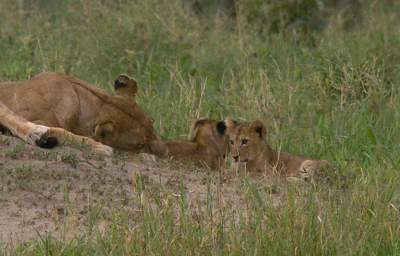 |
| Photo by Dona |
Douglas had a quick eye and identified birds seemingly out of the corner of his eye sometimes. This black stork tried to sneak by, and I guess it pretty much made it. It landed a long way off and continued working its way downstream, and I didn't get my focus right.
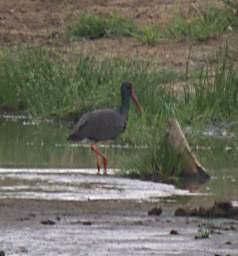 |
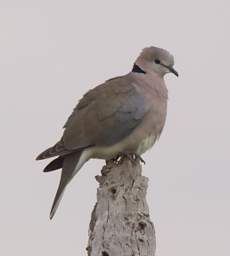 |
| Black Stork | Ring Necked Dove |
One of the difficult parts about the Tanzanian National Parks is that they require you to stay in your vehicle at all times. I don't know if that's because they're worried about tourists being gobbled up, or tourists trashing out the resources. In any case, it makes getting down on the ground to see small stuff a pain in the neck. I can't remember where we found these army ants, but we couldn't follow them or backtrack to see where they were coming from. I think Douglas said they had just raided a termite mound and were carrying the food home.
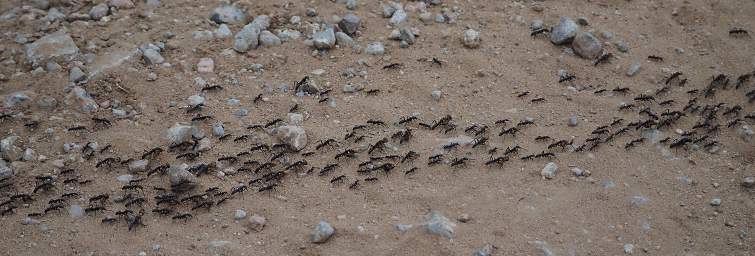 |
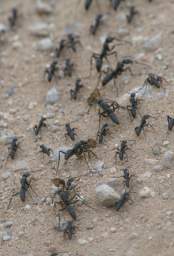 |
| Photo by Dona | |
| Army Ants | |
In the sparse woodlands we found vervet monkeys...
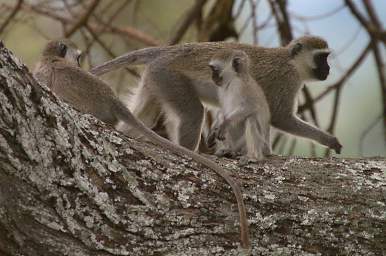 |
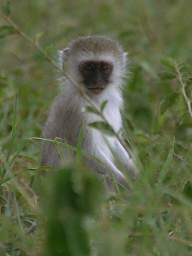 |
| Black Faced Vervet Monkey | |
And in the open spaces we found spurfowl scavanging for bugs.
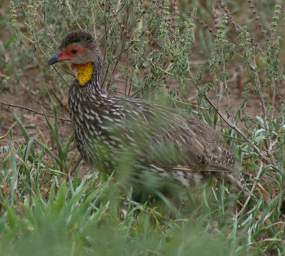 |
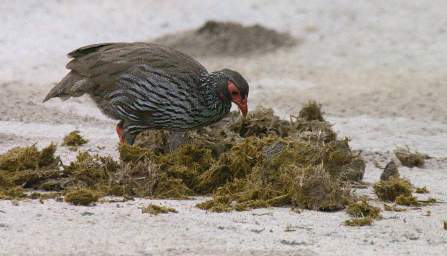 |
| Yellow Necked Spurfowl | Red Necked Spurfowl |
And always, up in the trees, the camp followers -- carrion eaters.
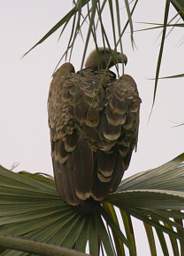 |
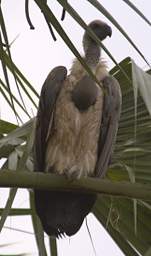 |
| African White Backed Vulture | |
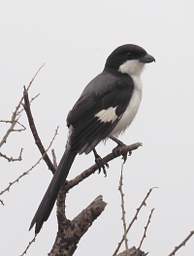 |
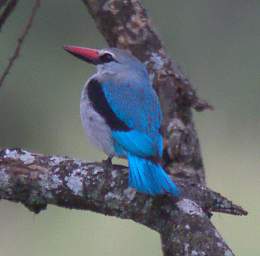 |
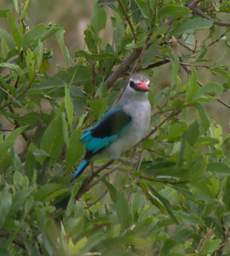 |
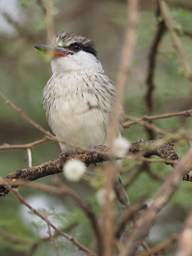 |
| Long Tailed Fiscal Shrike
Photo by Dona |
Woodland Kingfisher | Striped Kingfisher
Photo by Dona |
|
It was pretty impressive to see how high up an elephant could reach to get something to eat. In the dry season, there is probably a clear advantage to being tall.
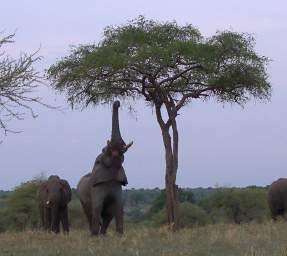 |
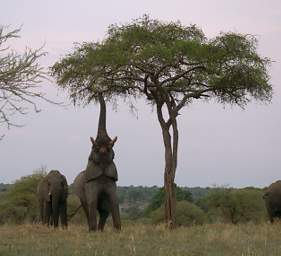 |
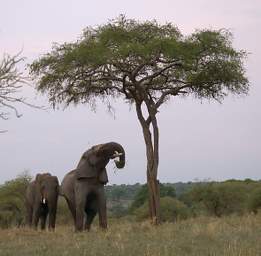 |
| Sometimes the food is a long ways up there... | ||
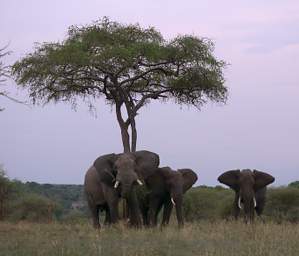 |
| Uh... sorry guys, we didn't really mean that...
whatever it was |
I got up to watch the sun come up, hoping for one of those great African sunrises you see pictures of. Unfortunately, we had nothing but very hazy dawns. But it was good to be up early anyway, watching the animals on the move. There were a couple of lions wandering around across the river, and boboons, dikdiks, hornbills, and other critters walking through camp.
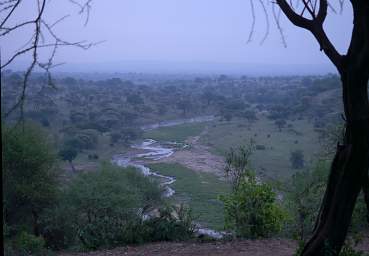 |
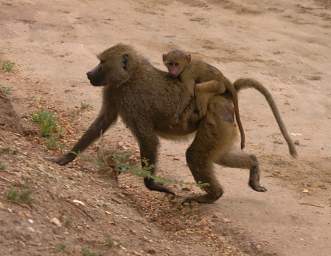 |
| Morning Creeps up on the Tarangire River | Olive Baboon with Baby |
The helmeted guineafowl are another of those crazy looking birds that defy explanation. How they survive as a species in all their apparent dumbness is beyond me. But survive they do, and the world is more colorful for it!
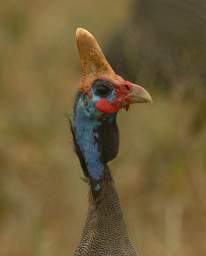 |
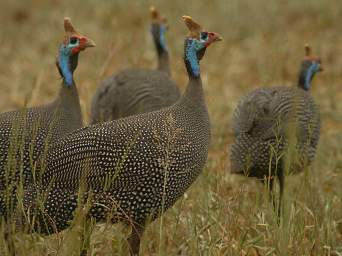 |
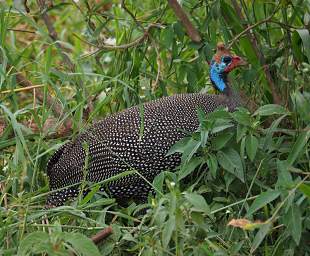 |
| Photo by Dona | ||
| Helmeted Guineafowl | ||
We didn't see a lot of woodpeckers on this trip, so whenever we found one it was a treat, even if the light was hard to deal with.
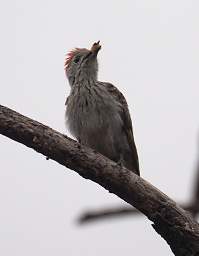 |
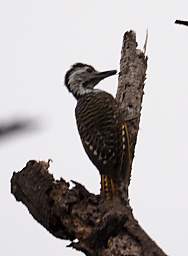 |
| Cardinal Woodpecker
Photos by Dona |
|
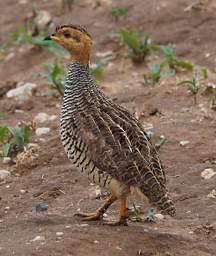 |
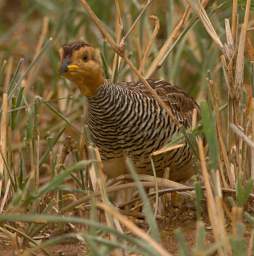 |
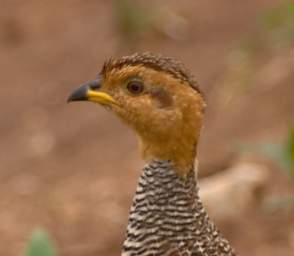 |
| Photo by Dona | A Bird with Attitude! | |
| Coqui Frankolin | ||
The striped swallows were pretty funny looking, with mud all over their beaks from working on their nests.
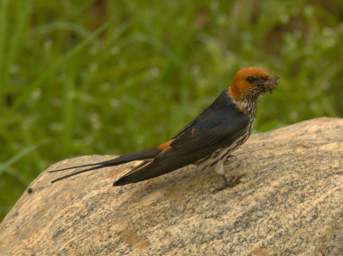 |
| Lesser Striped Swallow |
In rocky areas we saw rock hyraxes, which look like a small furry rodent. However, their closest living relatives are the elephant, the dugong, and the manatee. Evolution is pretty bizarre, huh?
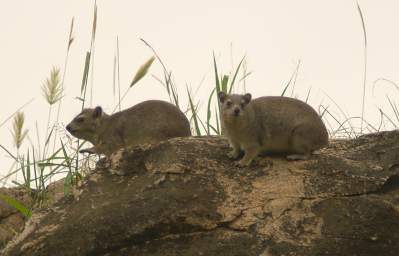 |
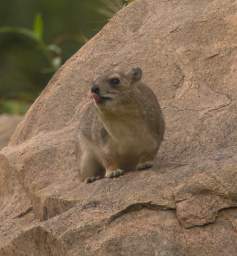 |
| Rock Hyrax | |
The diversity of birds never ceased to amaze and delight us.
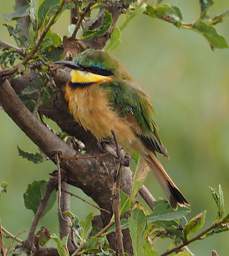 |
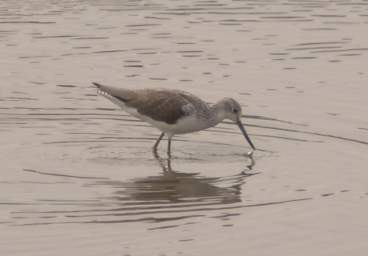 |
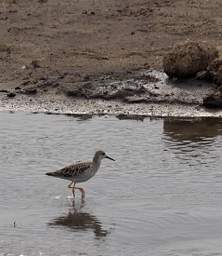 |
| Little Bee Eater
Photo by Dona |
Common Greenshank | Wood Sandpiper
Photo by Dona |
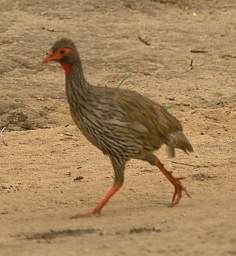 |
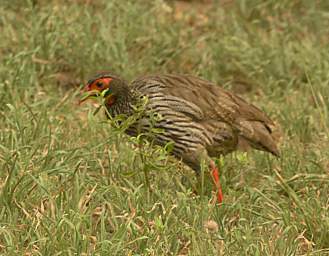 |
| Red Necked Spurfowl | |
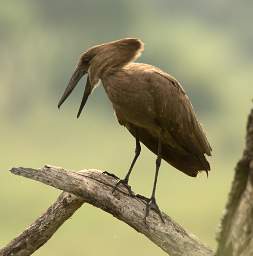 |
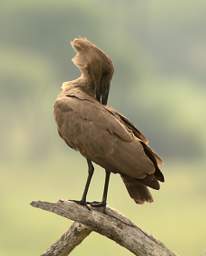 |
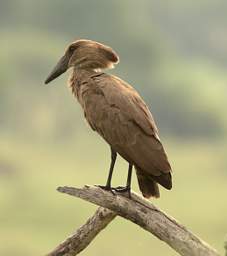 |
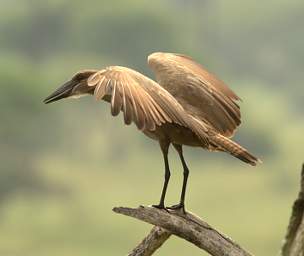 |
| Hamerkop | |||
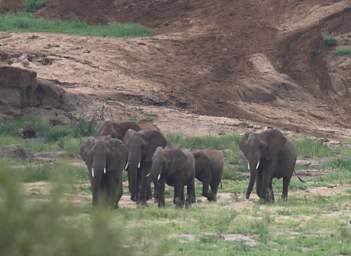 |
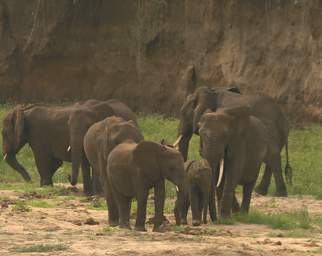 |
| Another small group of elephants | |
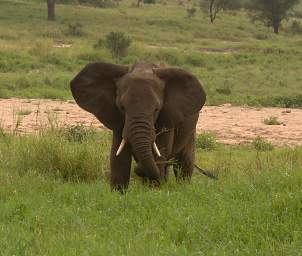 |
| Young Elephant |
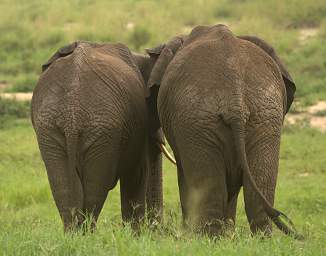 |
|
| Sometimes they're best pals and get along ... | |
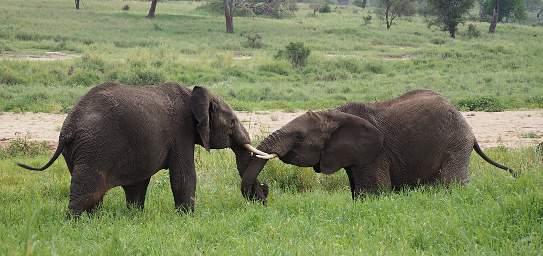 |
| ... and Sometimes they Don't
Young Elephants Learning about Dominance Photo by Dona |
I was often struck be the shear abundance of wildlife. We would often look out on a landscape and see a great diversity of creatures, something I'm not used to. Here at home, we usually see things one individual, or one species, at a time. In the photo of the baboon and impala below, there were also elephants within sight close by.
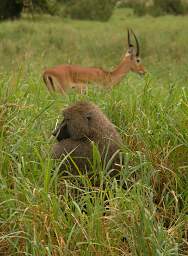 |
| Olive Baboon Impala |
And where there's one baboon...
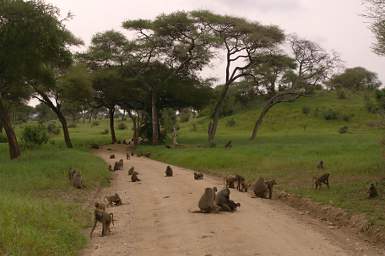 |
| There are often a whole boatload.
(and an elephant way back on the left) |
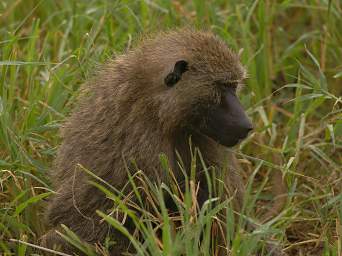 |
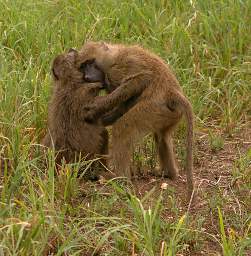 |
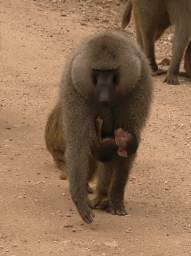 |
| Olive Baboon | Baboon Hugs | Olive Baboon with Baby |
The number of different kinds of antlered ungulates in Tanzania is large. I don't know if it's my advancing senility or just incompetence, but I have a heck of a time keeping them straight. So... these are impalas.
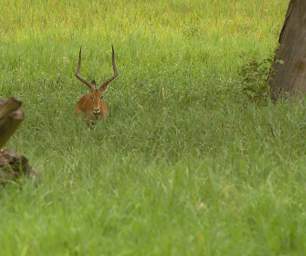 |
| Impala |
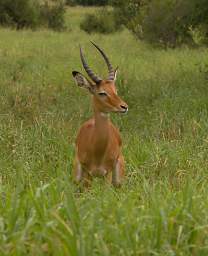 |
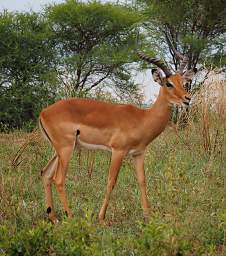 |
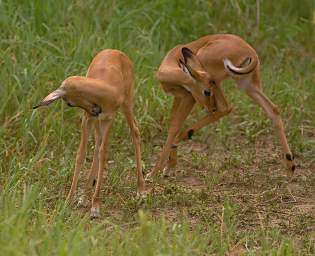 |
| Impala | Impala
Photo by Dona |
Young Impalas Scratching |
And this is a Reedbuck. See what I mean?
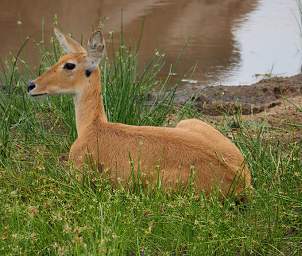 |
| Reedbuck (female)
Photo by Dona |
And these are something else entirely.
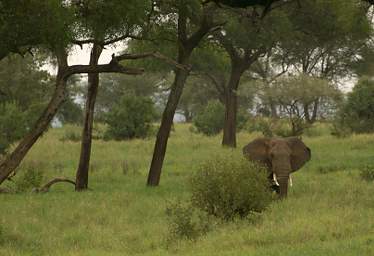 |
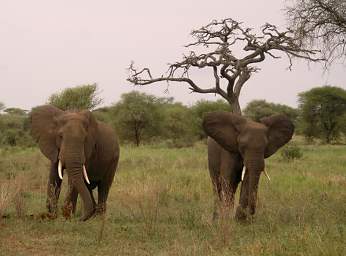 |
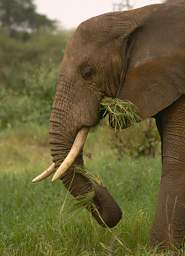 |
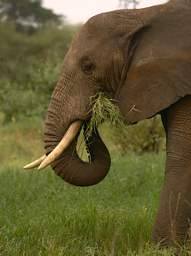 |
| Elephant Eating | |
We came across an elephant giving itself a proper dust bath. I didn't realize they sucked up dust in their trunks and then sprayed it out over their body. What I'd like to know is how they keep it out of their lungs. I've never been able to suck something up "part way" without at least some of it going too far. Think siphoning gasoline. Blech! It makes my lungs hurt just thinking about sucking dirt part way up my nose.
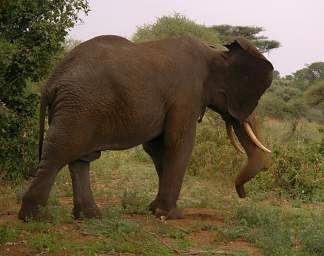 |
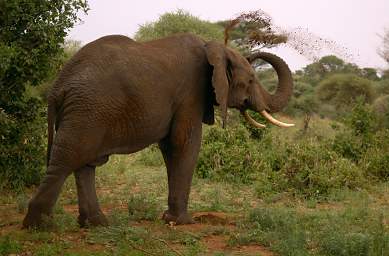 |
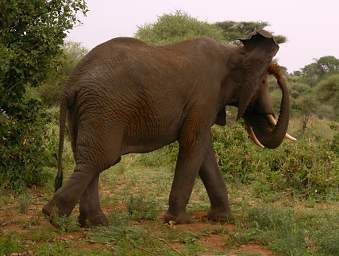 |
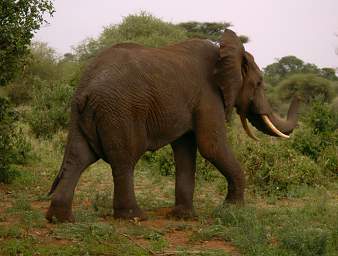 |
| Elephant Dust Bath | |
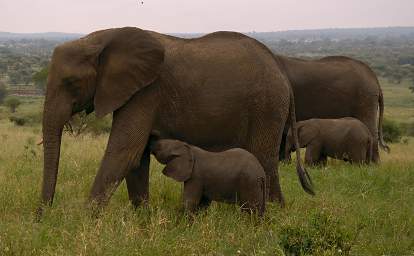 |
| Baby Elephant Nursing |
Dona and I have searched high and low trying to figure out what this next bird is. Nothing seems to fit.
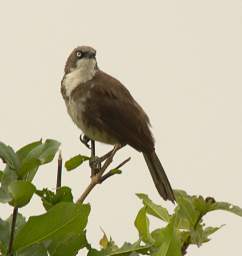 |
| Douglas, help!
What the heck is this? |
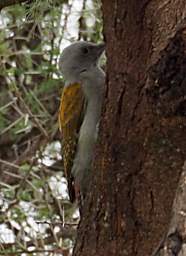 |
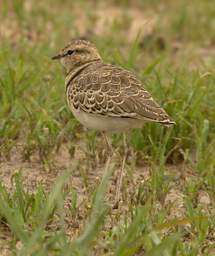 |
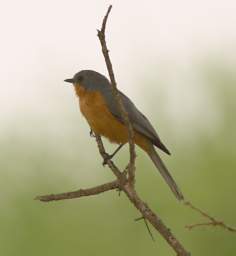 |
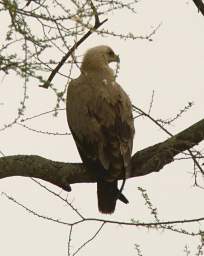 |
| Grey Woodpecker
Photo by Dona |
Two Banded Courser | Silverbird | Xxx |
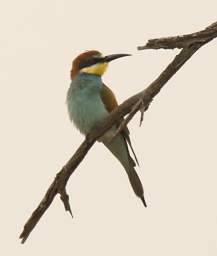 |
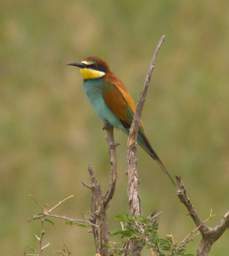 |
| European Bee Eater | |
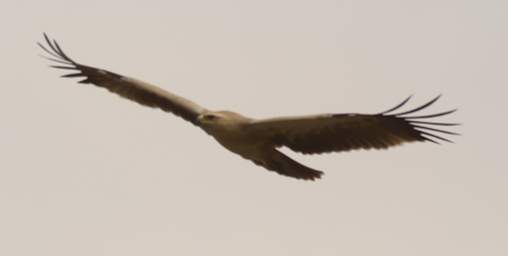 |
| Xxx |
On our second day we headed for Salale Swamp. We started off crossing over high ground, winding our way past bushy "bush" country, where you couldn't see too far through the undergrowth. I always wonder how much we don't see because we're traveling noisily and confined to the road. It would be interesting to get an infrared picture looking down on one of these places at the same time as you're traveling through it. But you never know what you'll find if you keep your eyes open.
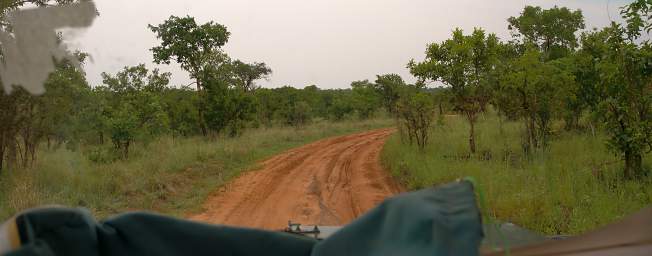 |
| Tarangire Bush Country |
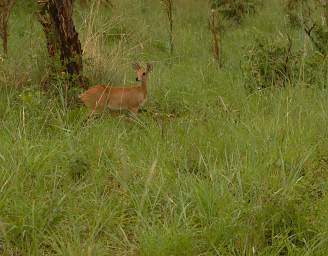 |
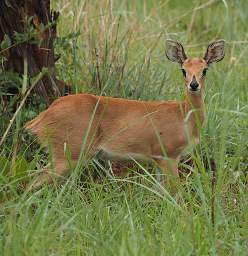 |
| One of those ungulates
that's hard to keep straight. |
Photo by Dona |
| Steenbok | |
When we topped out and could see off into the distance, we could see a substantial mountain. I asked douglas what it was and I thought he said Oldonyo Sambu, but I must have heard wrong / written it down wrong. I'm pretty sure that's not what that peak is named, as everything I've read says Oldonyo Sambu is a barely elevated region up by the Kenyan border. But maybe that's the official text, and locally there is a more prominent peak by that name.
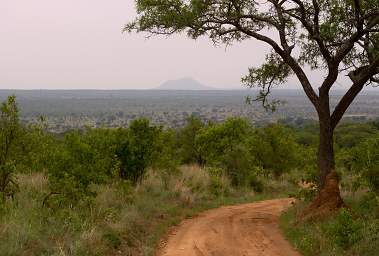 |
| Oldonyo Sambu
Note the termite mound in front of the tree. |
As we were wandering through the bush we did come across some nice flowers and a few awesome birds.
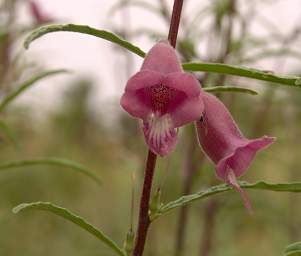 |
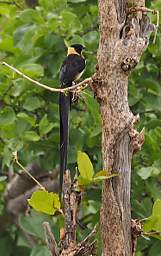 |
| Flower Xxx Pink | Eastern Paradise Whydah
Photo by Dona |
We got to the edge of the swamp, which looked like one huge grassland. We were primarily looking for birds, but fundamentally we were looking for anithing animate. We came up to this tree by the road that didn't look quite right. At least it didn't look quite right to Douglas. He stopped and said "Leopard." I looked. and looked. and looked some more. It took a very long time for me to find the dang thing, lying right there in plain sight.
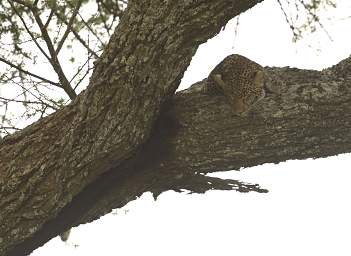 |
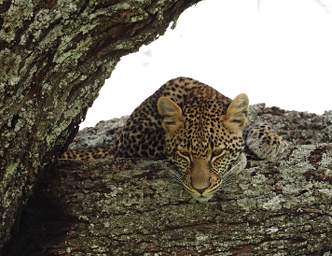 |
| It wasn't hidden, but it wasn't obvious either,
especially with the bright backlight. |
Leopard
Photo by Dona |
I was thinking we would see more flowers at the swamp, but there were few.
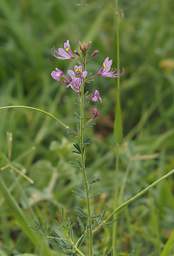 |
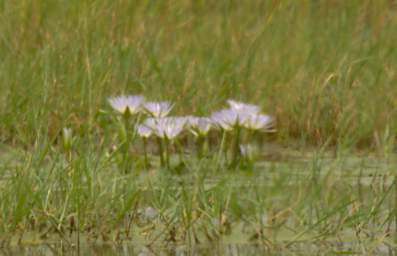 |
| Flower Lavender Yellow
Photo by Dona |
Flower Xxx Lavender |
There were, however, lots of birds. As usual, some of them were pretty weird looking. I swear someone dresses them up each morning.
 |
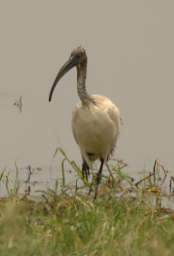 |
| Open Billed Stork | Sacred Ibis |
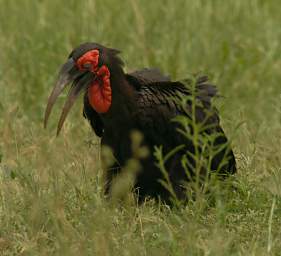 |
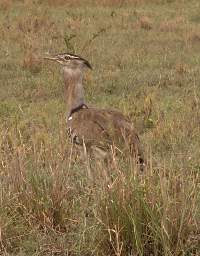 |
| Southern Ground Hornbill | Kori Bustard |
We came across some bee eaters which were foraging, and Dona managed to get a picture of one of them eating a bee. Or something.
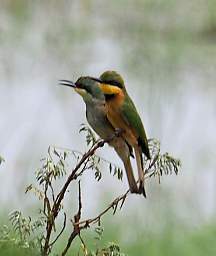 |
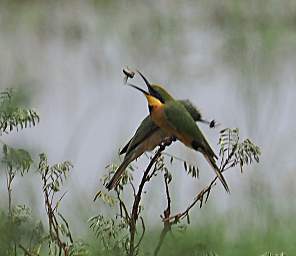 |
| Little Bee Eater
Photos by Dona |
|
We came across some ostriches, and then some more ostriches which panicked and ran around like crazy for some reason. One went one way, the other went another way. If I were a predator trying to catch one I would be pretty confused at first.
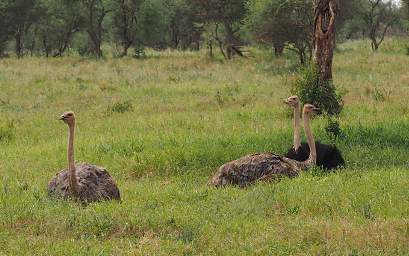 |
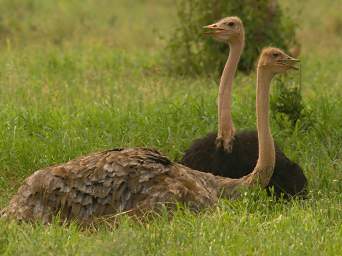 |
| Ostrichs
Photo by Dona |
Ostrichs |
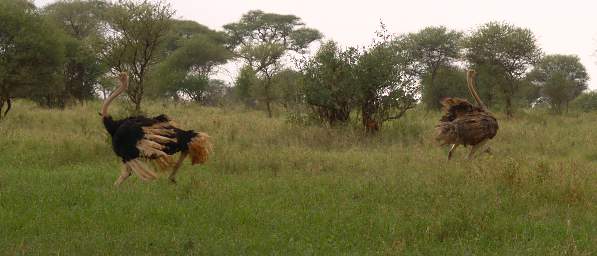 |
| This would be distracting if I were a predator ... |
We were going to stop for lunch at a picnic area near the southern end of the swamp, but there was another party already there, so we continued around the swamp until we found a shady spot underneath an acacia tree by the road. After lunch we continued on, looking for birds or whatever else we could find.
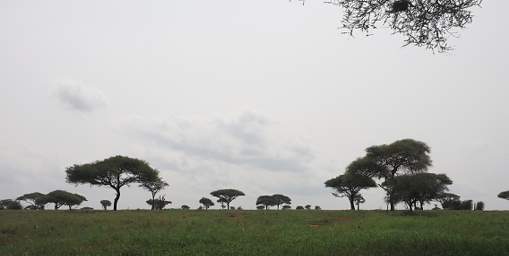 |
| Photo by Dona |
 |
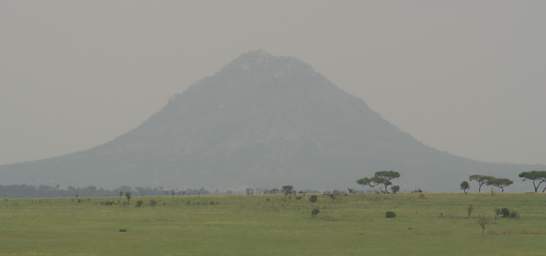 |
| Oldonyo Sambu |
The first thing we noticed was a carcass.
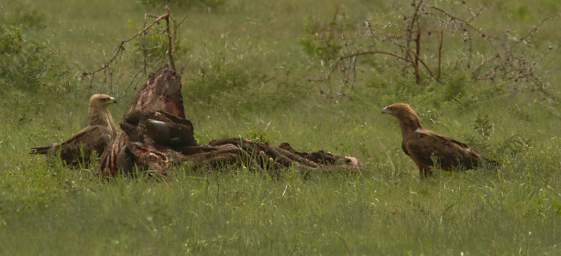 |
| Carcass |
The next thing we noticed was a big male lion cooling off under a tree. And a black-backed jackal hiding in a bush nearby, apparently totally unconcerned about the proximity of the lion.
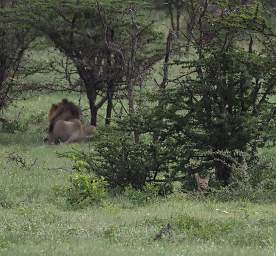 |
| Lion and Black Backed Jackal
Photo by Dona |
Then we noticed a lioness under another tree, and eagles hanging out in yet another.
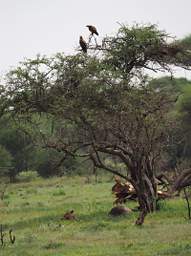 |
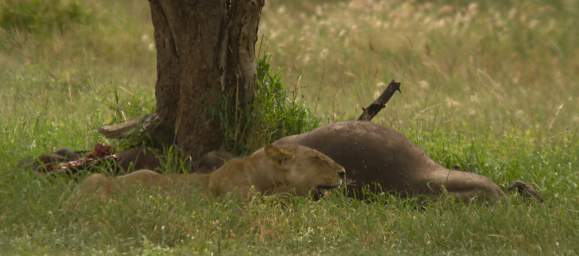 |
| Lioness and Tawney Eagles
Photo by Dona |
Lioness with Carcass |
The more we looked, the more lions we saw.
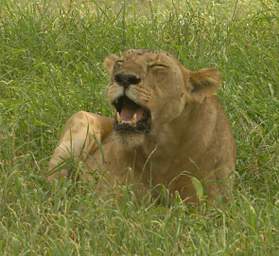 |
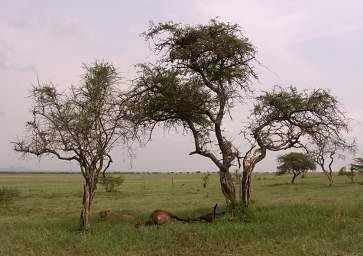 |
| Lioness | Lioness with Carcass |
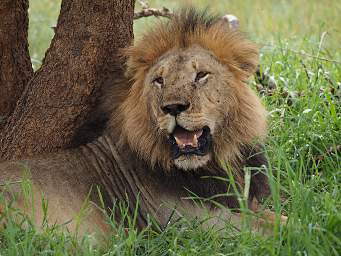 |
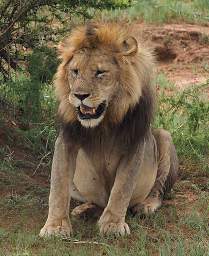 |
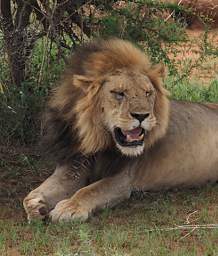 |
| Lion
Photos by Dona |
||
There were young kids prowling around, but none of them were really interested in any of the carcasses. Everybody seemed to be just plain stuffed.
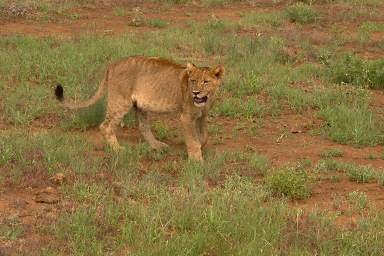 |
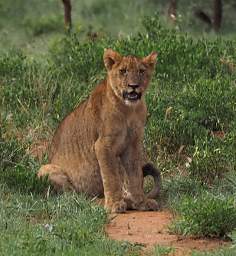 |
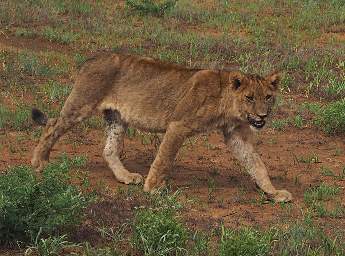 |
| Photo by Dona | Photo by Dona | |
| Lion Kid | ||
There were the usual hangers-on in some abundance, not quite as lethargic as all the lions.
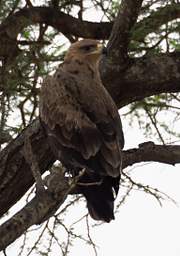 |
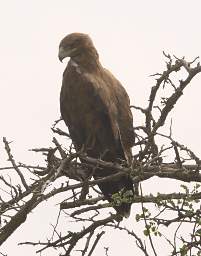 |
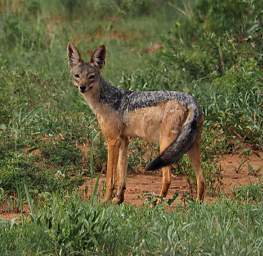 |
| Tawny Eagle
Photo by Dona |
Brown Snake Eagle | Backed Jackal
Photo by Dona |
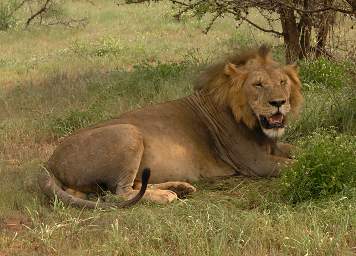 |
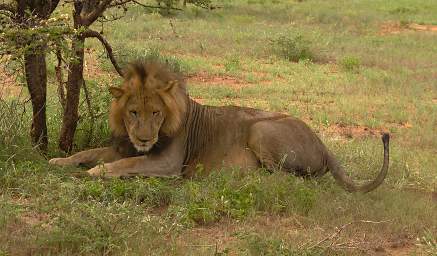 |
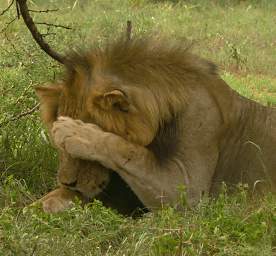 |
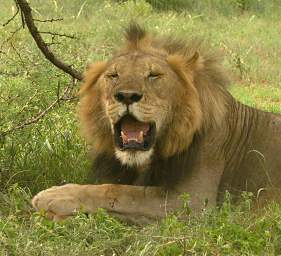 |
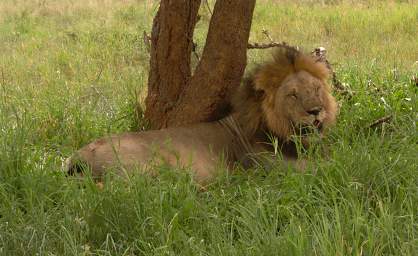 |
| Irritated by Flies |
We would look at a tree with a lioness at the bottom of it, and then realize that there were more lions up in the tree. Sometimes there would be one cub. Sometimes there would be a whole passel of cubs. Sometimes there would be a big male lion. Sometimes there would be a male lion and a passel of cubs. This would not be a good place for your vehicle to break down.
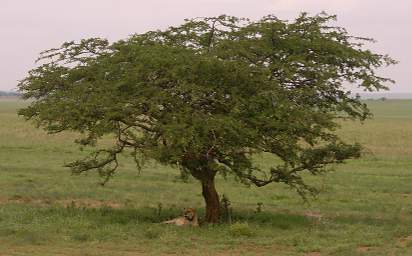 |
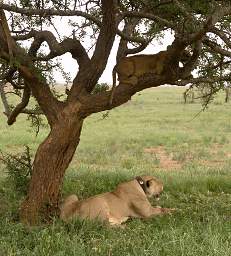 |
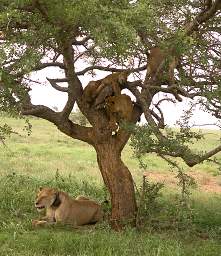 |
| Lioness Plus Tree | Collared Lioness and Cub In Tree | Lioness with Cubs In Tree |
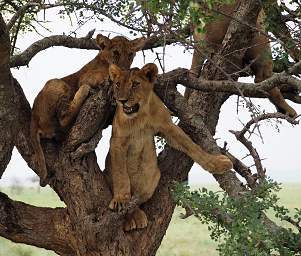 |
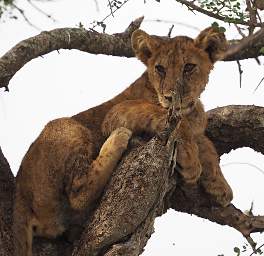 |
| Photos by Dona | |
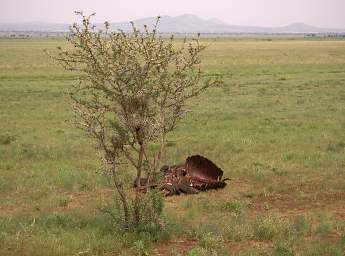 |
| Carcass |
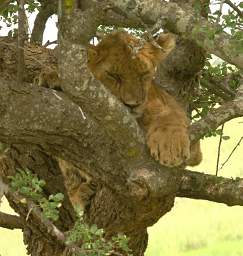 |
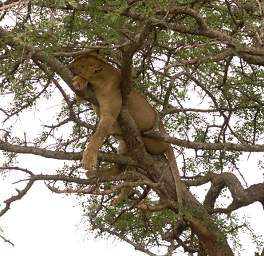 |
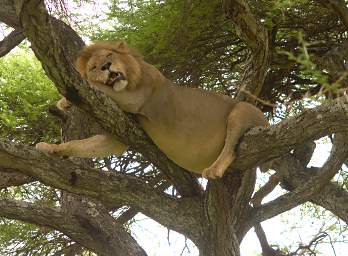 |
| Lion Cub In Tree | Lioness In Tree | Lion In Tree |
There was a lioness sitting on a termite mound, as if she were a kid playing "King on the Mountain."
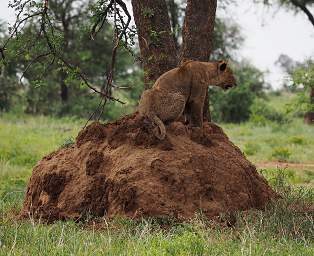 |
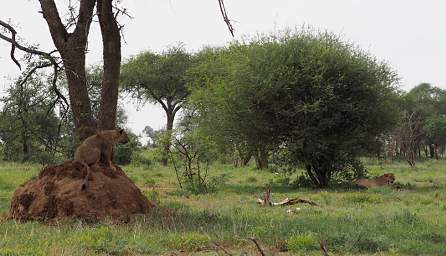 |
| Lioness on Termite Mound
Photo by Dona |
Lioness on Termite Mound
another under tree nearby. Photo by Dona |
It was getting later in the day and we had a long drive back to our tent / lodge, so we turned around and headed back. I don't know how many lions we saw all told in that one spot. fourteen or fifteen, at least; we lost count, and it didn't seem important. On the way back we found yet another lioness dozing by the side of the road. It seemed like the aftermath of a big frat party.
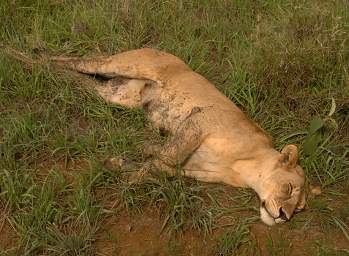 |
| Lioness By Road Flies |
We found some great termite mounds, which I went over and stood by so you could get an idea of how large they are. They're not small...
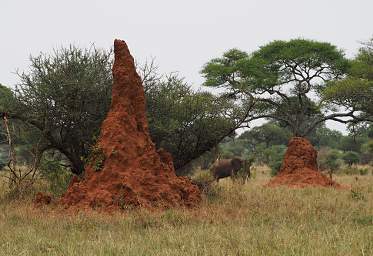 |
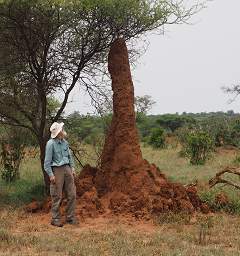 |
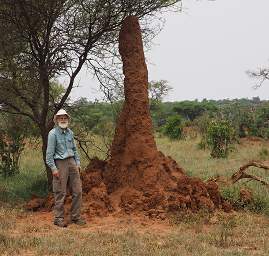 |
| Termite Mound
Photos by Dona |
||
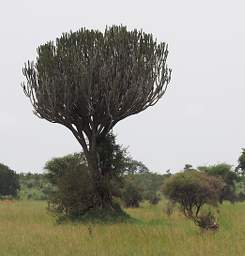 |
| Candelabra Tree;
it's almost like a different planet sometimes. Photo by Dona |
Our trip back was as eventful as the trip down, with both birds and larger animals.
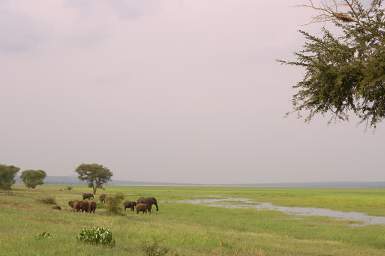 |
| Elephants at edge of Salale Swamp |
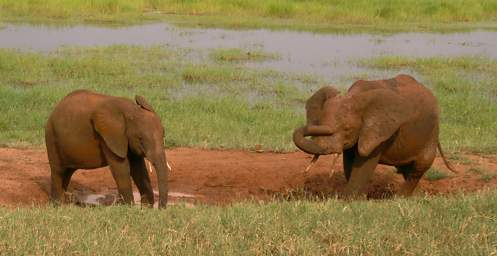 |
| Young Elephants Taking a Mud Bath |
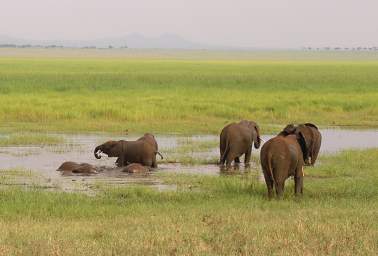 |
| Elephants Cooling Off |
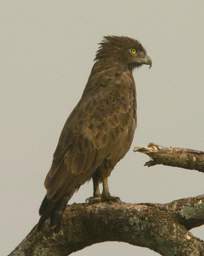 |
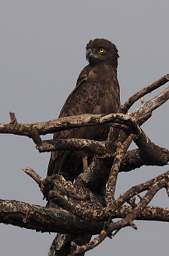 |
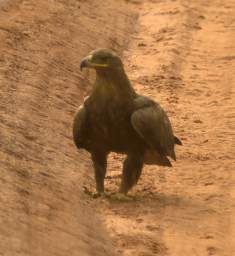 |
| Xxx Imm Black Chested Snake Eagle | Xxx Eagle
Photo by Dona |
Steppe Eagle On Road |
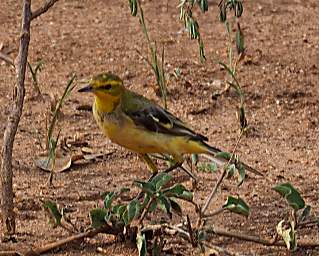 |
| Xxx Yellow Throated Longclaw
Photo by Dona |
We came across several different species of mongooses, always busily foraging.
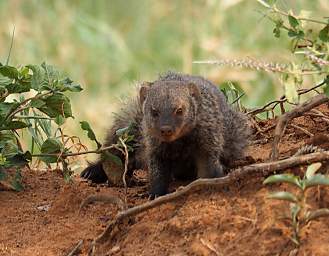 |
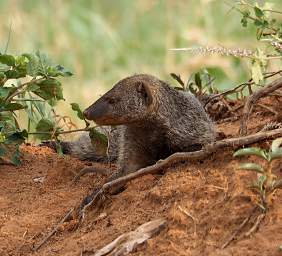 |
| Slender Mongoose
Photos by Dona |
|
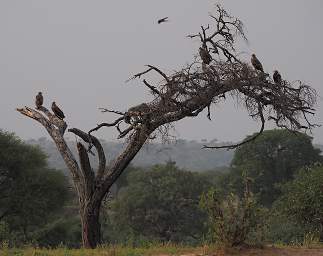 |
| Raptor Tree |
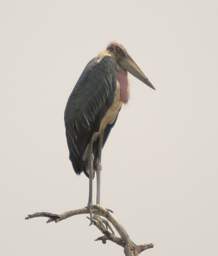 |
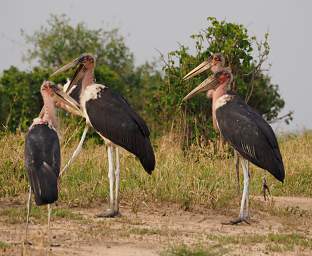 |
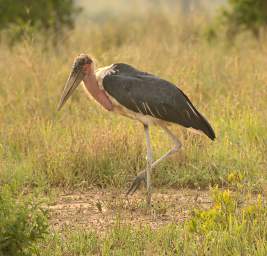 |
| Photo by Dona | ||
| Maribou Stork | ||
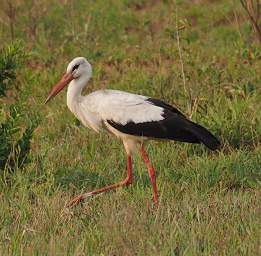 |
| White Stork
Photo by Dona |
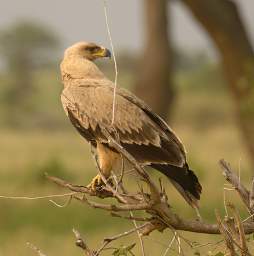 |
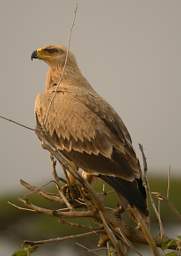 |
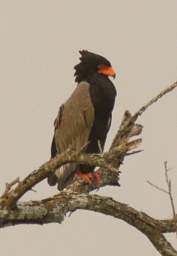 |
| Tawny Eagle | Bateleur Eagle | |
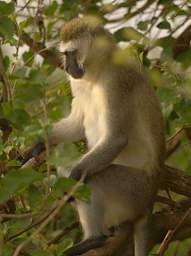 |
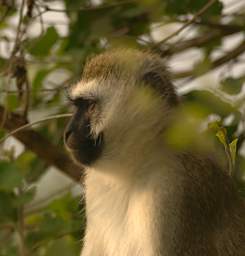 |
| Vervet Monkey | |
Whenever we came up to another vehicle heading the opposite direction, Douglas always stopped to say hello to the driver and spend a few minutes catching up. Some of them were people he knew, but many weren't. But everyone seemed to enjoy talking with him. One of the people we came across was a guy heading home with his wife and young child. That was one happy kid. Imagine growing up with all this great wildlife all around you! It looks like he was getting used to using the binoculars already.
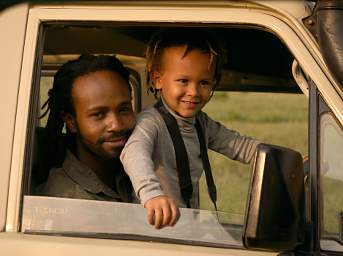 |
| Boy And Dad |
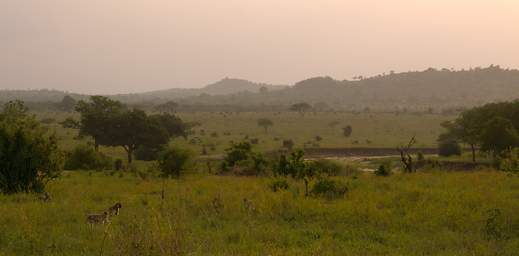 |
| Tarangire River |
 |
The slender mongooses we saw earlier tend to be solitary, but when we came across banded ones it was like a big party. I don't know what you call a bunch of mongooses, but whatever you call it -- a herd, a gaggle, a band, a boatload -- there were a bunch of them. They were busily scurrying around and chattering to each other like it was some big social event. They seemed to be chomping away on bugs of some kind.
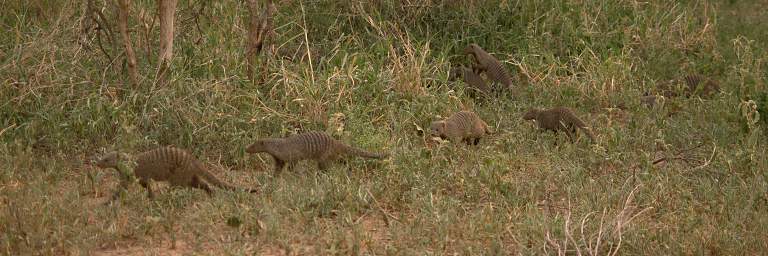 |
| Banded Mongoose |
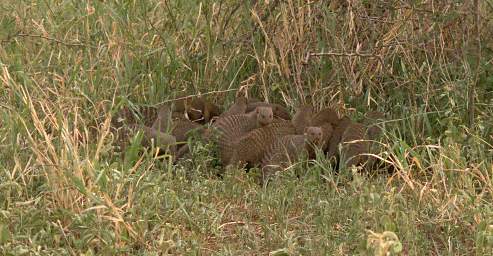 |
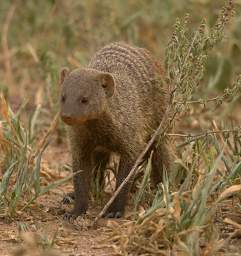 |
| Banded Mongoose | Banded Mongoose |
One of our favorite birds was the Go-Away bird, of which there are several species. Apparently they are great sentinels, and raise a ruckus when they see a predator. Which alerts all the other animals around, and the predators just "go away" in disgust.
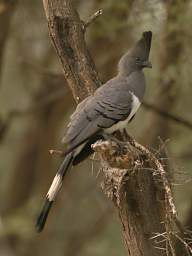 |
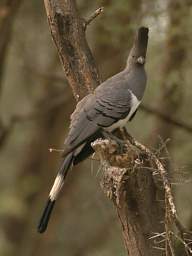 |
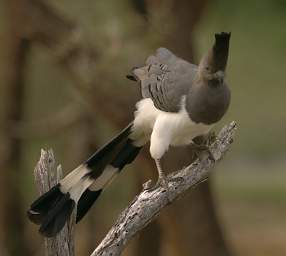 |
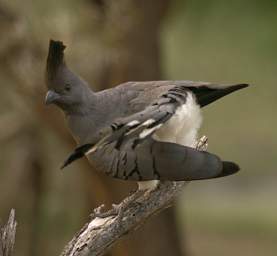 |
| White Bellied Go Away Bird | |||
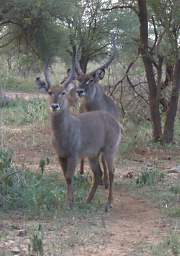 |
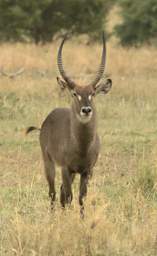 |
| Waterbuck | |
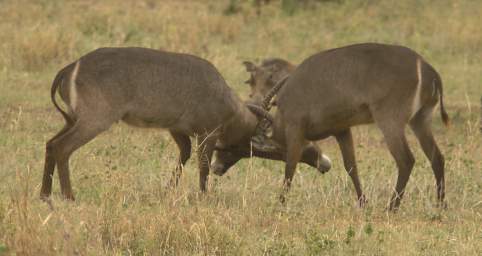 |
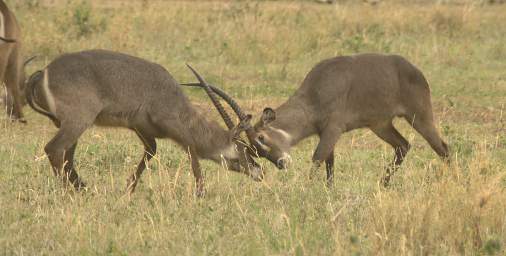 |
| Waterbuck Sparring | Waterbuck Sparring |
After a good night's sleep, we took a leisurely route out of the park. One of the first things we saw were fresh cat tracks, on top of all the vehicle tracks. But we didn't see the author.
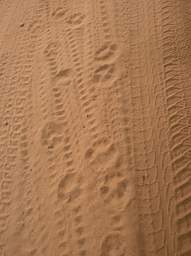 |
| Cat Tracks |
But we did see more cool birds, especially the Scarlet Chested Sunbird.
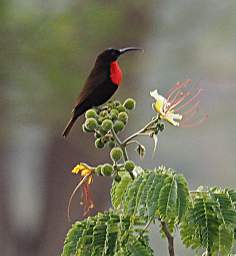 |
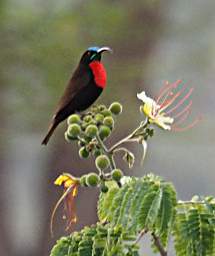 |
| Scarlet Chested Sunbird
Photo by Dona |
|
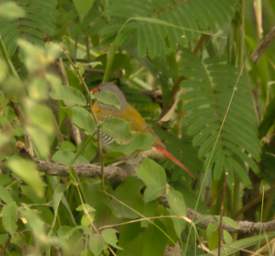 |
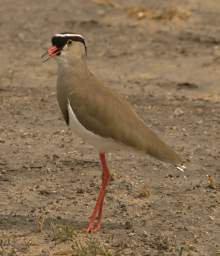 |
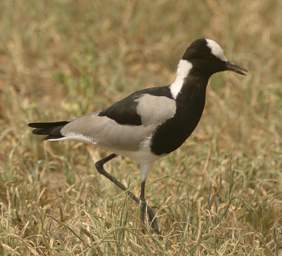 |
| Green Winged Pytilia | Crowned Lapwing | Blacksmith Lapwing |
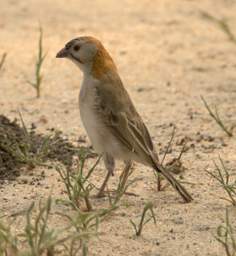 |
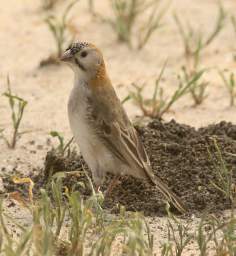 |
| Speckle Fronted Weaver | |
The weavers are so named because they generally make nests by weaving their building materials together. Some of them are very organized, and others are pretty haphazard. The photos of weaver nests below were taken in two different places on different days, and are not nests of the same species. As I recall there were no birds around when we saw these nests.
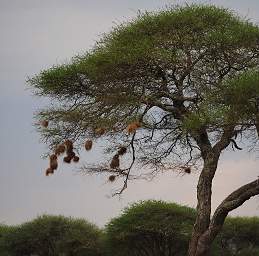 |
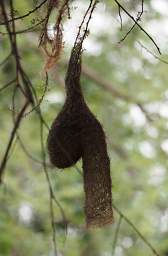 |
| Weaver Nests
(These are not speckle-fronted weaver nests) Photos by Dona |
|
When we came upon the Cordon Bleus, it was hard to believe they were real birds. The colors were so vibrant and "non-natural." They looked like a kid's paint-by-numbers product.
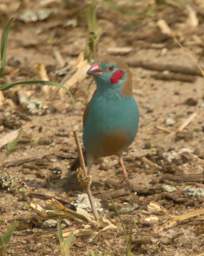 |
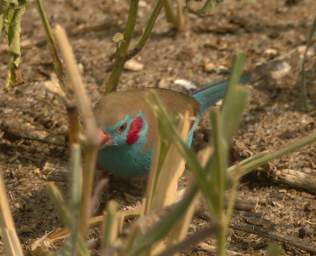 |
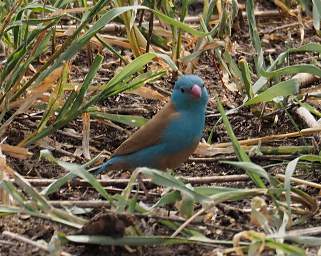 |
| Red Cheeked Cordon Bleu | Female
Photo by Dona |
But right next to the Bordon Bleus was a Spotted Morning Thrush, which was just about impossible to see even when we knew it was there and Douglas was pointing at it. That bird is well camoflaged.
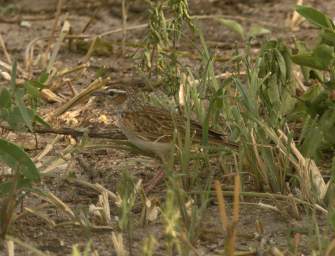 |
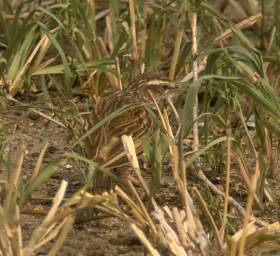 |
| Spotted Morning Thrush | |
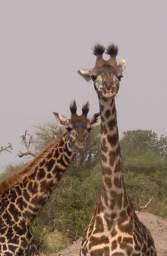 |
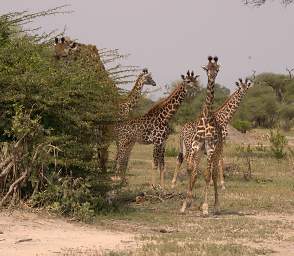 |
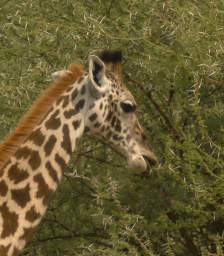 |
| Giraffes | ||
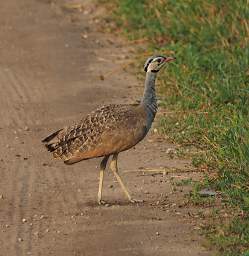 |
| White Bellied Bustard
Photo by Dona |
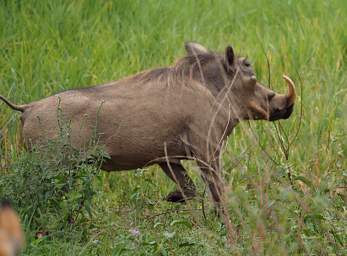 |
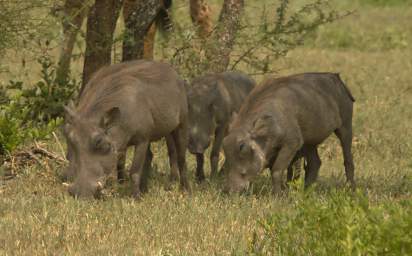 |
| Photo by Dona |
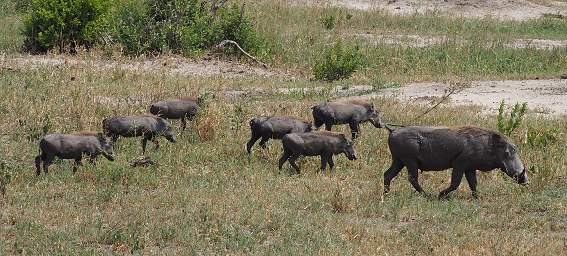 |
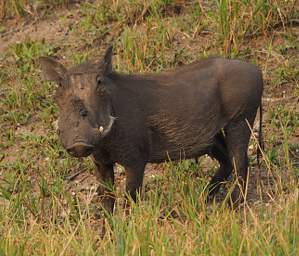 |
| Photos by Dona | |
| Warthogs | |
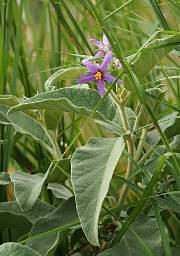 |
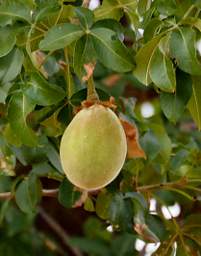 |
| Tarangire NP Flower Xxx Lavender Yellow | Tarangire NP Tree Fruit |
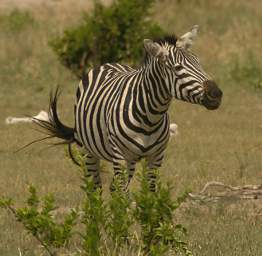 |
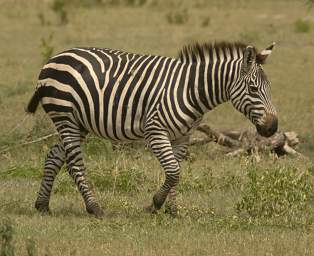 |
| Burchells Zebra | Zebra |
I was reluctant to be leaving Tarangire National Park. We could have easily spent a whole week or more slowly exploring around. We only visited the northen half, and even then the scene changes constantly. What a wonderful abundance and show by mother nature!
Tarangire Lodge is too big to be what I would call "nice." Things become impersonal even when it's not, if that makes sense, just by virtue of so many people being all in one bunch. In addition, if you're primarily interested in wildlife and not luxury living, you don't have time to enjoy the amenities you're paying for. We were out from dawn until dusk, and by the time we were done eating we barely had time to tend to our camera gear and then crash. So a fancy pool is useless to us, as is a bar and sundowners. We would have stayed out later if we could have. They are also rather regimented in their dining, not liking you to eat outside on the patio where you can actually enjoy what you came here for. They say that's because of the animals which come and steal food; I guess if you're not used to dealing with wildlife, which is probably 99% of their customers, that makes sense. But it's frustrating for me since we live in a place where we have to keep really clean camps because of the grizzly bears. They also tend to push drinks on you, I suspect because they're a profitable revenue stream. We generally prefer just good water or fruit juice, so we don't contribute too much in that department.
Our next stop was in the Nou Forest.